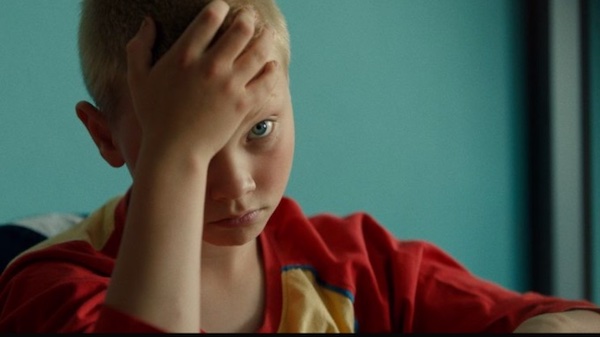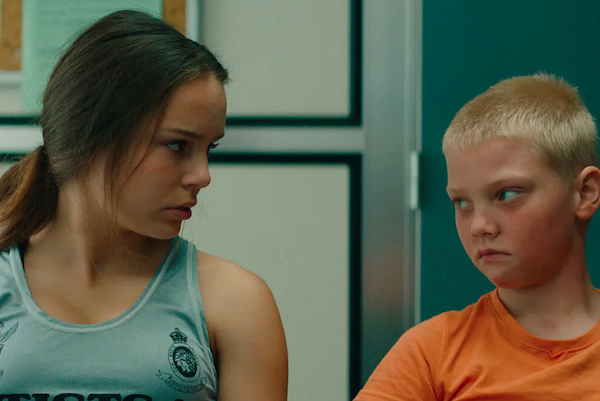Film Review: “The Worst Ones” — Dramatizing the Children of the Underclass
By Tim Jackson
The Worst Ones is a distinctive cinematic achievement – it is deeply moving film that offers a critique of itself.

A scene from The Worst Ones. Photo: Les Films Velvet
The Worst Ones directed by Lise Akoka & Romane Gueret. The film is part of the Belmont World Film Series. Screening at Apple Cinemas on April 10 at 7:30 p.m.
The Worst Ones, the Certain Regard award winner at Cannes, presents a film-within-a-film set in a housing project in the Boulogne-Sur-Mer, on the coast of Northern France. The fictional director of the movie (within the movie) has plucked “the worst ones” from the Cite Picasso housing project 170 miles to the south. The rationale for the casting decision appears to be motivated by an interest in investigating the lives of troubled youth.
Among the “performers” is Lily, played by Mallory Wanecque, a 17 year-old whose sexual history generates taunts and rumors by her male peers. She will be pregnant by the film’s end. She is also grieving for her little brother, who was lost to cancer. Little Timéo Mahault is Ryan, a pre-teen boy she befriends. His father is out of the picture and his mother is involved in substance abuse and is too unreliable to raise him. He lives with his older sister and experiences outbursts of anger and stress. “I have never cried,” he bravely tells the director.
Loïc Pech is Jessy, a volatile young man who at one point is directed to make-out with Lily, clad only in a bra and panties. This is one of the film’s queasier scenes. Soon after, Jesse angrily accuses the director of exploiting him and the other adolescent cast members. Along with his male friends, he taunts and insults Lily. Meanwhile, Lily is precociously confident about her sexuality; she appears to have enjoyed the scene. Despite her seeming confidence, however, she suffers from deep insecurities. Judith, a production assistant played by Esther Archambault, takes a sincere interest in the girl, engaging her in long confessional conversations.
Pulling this all together is the film-within-the-film’s director Gabriel, played by a wonderfully grinning Johan Heldenbergh, the only professional in the cast. At times he seems to be manipulating these kids, cultivating their reactions. Yet there is also a protective and fatherly quality to his relationship with them.
All of this, one reminds oneself, is a fictional world cast with novice actors. The line between reality and fiction has been intentionally blurred. The performances are so authentic that at times it is impossible to decide whether the children are acting, being themselves, or engaging in psychodrama. The opening begins with what might be an actual audition for a film. Immediately we are left to question whether the young actors are auditioning for the movie we are watching — or the film-within-the-film. Slowly, The Worst Ones intertwines reality and fiction in a carefully constructed — but not necessarily linear — timeline that questions the relationship between political exploitation and artistic integrity. This conflict is put in stark relief in a scene in which the population of the housing project watches what we presume is the final shot of the fictional film. A scowling Ryan is told by the director that he has to “get this the first time.” As the director calls ‘action’ we see Ryan adorned with a prosthetic pregnant belly, held in the arms of a howling old woman, as 1000 pigeons are released into the air. What in the world is this symbolism about? The scene reads like a parody of an antiquated art film. But what movie is the image critiquing? Are the filmmakers lampooning themselves – or others who have attempted to dramatize the life of the young and outcast?
Besides dazzlingly interweaving fiction and reality, The Worst Ones is compelling because of its astounding performances. Should we direct our compassion at a character, an actor, or a combination of the two? At one point Judith, the PA, tells Ryan that he doesn’t have to make this movie if he doesn’t want to. Then she asks him: “Why are you so angry all the time?” Holding his head, and rocking back and forth, he responds: “It’s like my body inside is shaking all the time.”Is little Timéo Mahault speaking for himself? Or is this a line in the script? It is a haunting and heartbreaking moment.

A scene from The Worst Ones. Photo: Les Films Velvet
The “real life” directors of The Worst Ones are Lise Akoka and Romane Gueret, two casting agents whose past experiences have led them to want to examine what “street casting” does to and for children. In a previous short, Chasse Royale, they used non-professional young actors in a script that was built out of the conversations between the filmmakers and the actors. The Worst Ones is a continuation of that investigation.
The film falls into the tradition of “Banlieue” filmmaking, the work of directors that represent life in the deprived housing estates outside of large French cities. This has been labeled by some critics as “poverty porn,” attached as a superficial gesture by directors whose call for social action ends up exploiting the underclass. The title The Worst Ones plays into that troubling possibility. Still, overall, the film is an honest look at the psychological distress generated by poverty. It takes considerable risks: it is a meta critique of reality filmmaking as well as a portrait of drawing on inexperienced children as actors. They could be accused of indulging in the sins it condemns.
The casting of children has supplied remarkable performances, but also the occasional tragedy. History offers a mixed perspective. There was controversy around Luis Buñuel’s use of children in Los Olvidados in 1950. Ten-year-old Fernando Ramos da Silva, cast as a street thief in Héctor Babenco’s 1980 Brazilian film Pixote, was killed nine years later while resisting arrest following an assault. The NYTimes reported that he was “harassed by the police because they could not distinguish him from the role he played in the film.” More hopeful examples include the astounding five-year-old Victoire Thivisol in Ponette, who went on to some success as an actress. Five-year-old Brigitte Fossey in René Clément’s Forbidden Games (1952) and fourteen-year-old Dai Bradley Ken Loach’s in Kes (1969) both went on to successful careers in acting. Last year Lucas Dhonts Close featured two remarkable child performances (Fuse review) and SJ Finlay’s, Boy From Nowhere cast Gary Jumawan in a role that echoed his life as a Moro National Liberation Front child soldier. Finlay followed up by offering the boy an education in Canada. Others, most notably the Dardenne Brothers (“Kid with a Bike”), are among the directors who have shown they can brilliantly direct young novices.
Performances by children elicit a special kind of empathy from viewers, who know they are seeing acting that is free of training or adult life experience. With the aid of clever editing, skilled and responsible directors can protect the vulnerability of adolescents. In the case of The Worst Ones, the directors — with assistance from writer Elénore Gurrey — made use of workshops, discussions, and rehearsals to hone and develop the script. The result is a distinctive cinematic achievement – it is a deeply moving film that offers a critique of itself. In terms of the real world, we can only hope that these kids will be cared for.
Tim Jackson was an assistant professor of Digital Film and Video for 20 years. His music career in Boston began in the 1970s and includes some 20 groups, recordings, national and international tours, and contributions to film soundtracks. He studied theater and English as an undergraduate, and has also worked helter skelter as an actor and member of SAG and AFTRA since the 1980s. He has directed three feature documentaries: Chaos and Order: Making American Theater about the American Repertory Theater; Radical Jesters, which profiles the practices of 11 interventionist artists and agit-prop performance groups; When Things Go Wrong: The Robin Lane Story. And two short films: Joan Walsh Anglund: Life in Story and Poem and The American Gurner. He is a member of the Boston Society of Film Critics. You can read more of his work on his blog.

